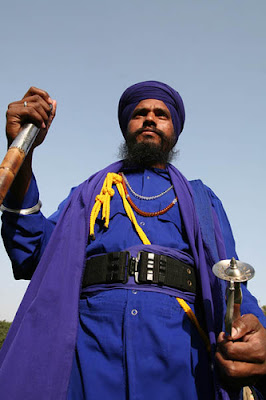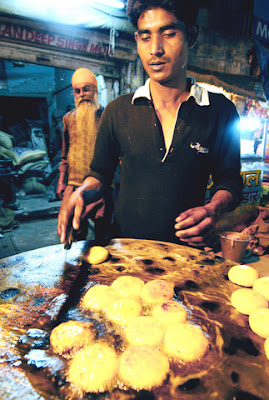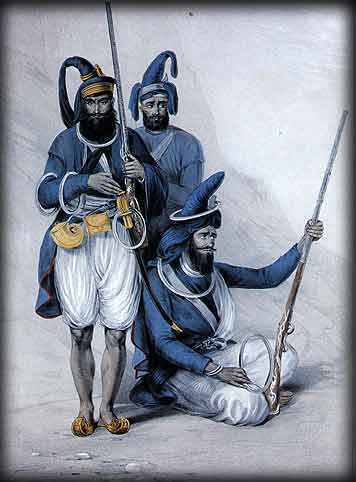
Three Nihang warriors
Nihangs can be recognized from a distance as they wear dark blue robes with their legs bare below the knees and high blue and yellow turbans laced with steel discs. They usually carry spears, swords, daggers and shields. They use a charming vocabulary of Braggadocio, which has found its way into the Punjabi language.
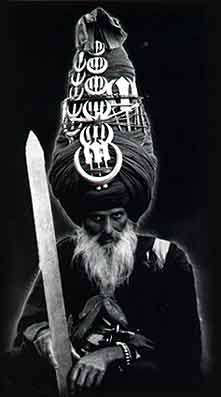
Nihang of the Buddha Dal with traditional "Dastar Bunga" turban, mostly worn on occasions such as Hola Mohalla.
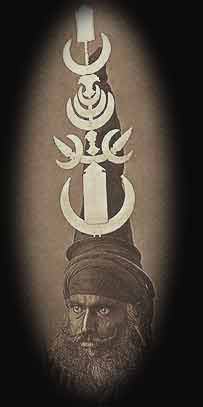
Nihang of Taruna Dal with traditional turban known as "Dastar Bunga".
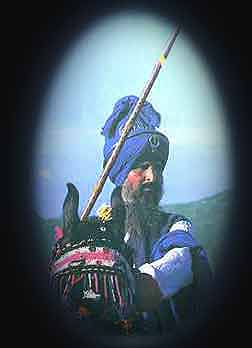
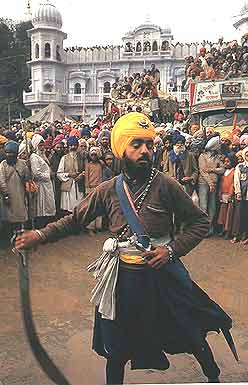
Nihangs at the Hola Mohalla Celebrations
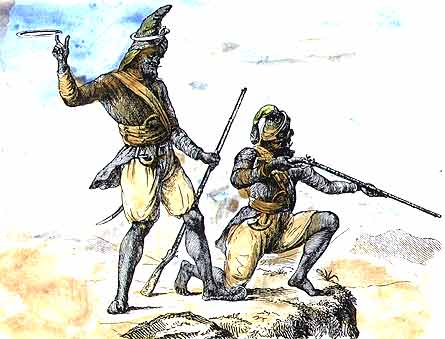
A sketch by a European Artist - from the Illustrated Weekly News, London
Nihangs in a final procession at the Kesgarh Sahib Gurdwara on the occasion of Hola Mohalla (photo courtesy Raghu Rai - "The Sikhs")
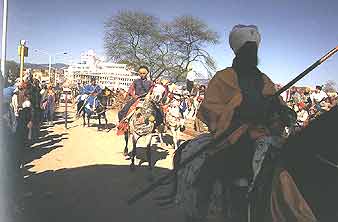

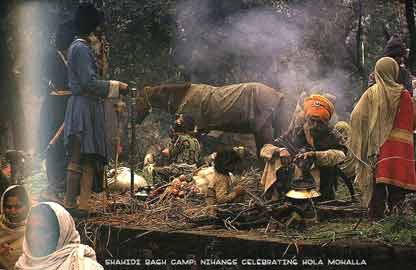
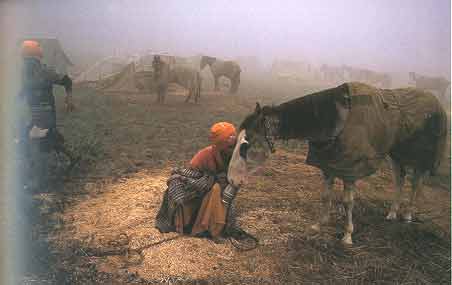
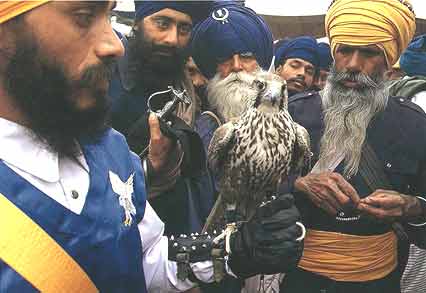
Falconry: Nihangs gather to admire a hawk (Symbolic of Guru Gobind Singh) trained to capture small birds. (photo courtesy-Raghu Rai) Nihang Horsemanship: Baba Santa Singh leader of the Buddha Dal, in a display of equestrian prowess. (photo courtesy - Raghu Rai -"The Sikhs")
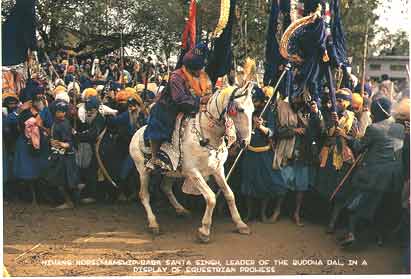
The following article is by H.A. Rose in his book "Tribes and Castes of Punjab and N.W. Frontier Province" (1892)
Akali/Nihang
The sect of the Akalis differs essentially from all other Sikh orders in being a militant organisation, corresponding to the Nagas or Gosains among the Hindus. Their foundation is ascribed to Guru Govind Singh himself, and they steadfastly opposed Banda's attempted innovations. The term 'Akali' is sometimes said to be derived from 'Akal-purusha' - 'worshipper of the Eternal.' But Akal means 'deathless', i.e. 'God', and Akali is simply 'God worshipper.' The Akali wear blue chequered dresses, and bangles or bracelets of steel round their wrists, and quoits of steel in their lofty conical blue turbans, together with miniature daggers, knives, and an iron chainIn their military capacity the Akalis were called Nihangs or reckless, and played a considerable part in the Sikh history, forming the Shahids or first of the four dehras. At the siege of Multan in 1818 a few Akali fanatics (They were headed by one Jassa Singh, called Mala (rosary) Singh, from his piety. He denied himself the use of bhang, the only intoxicating drug in use among the Akalis.) carried the faussebraye by surprise and precipitated the fall of that fortress.
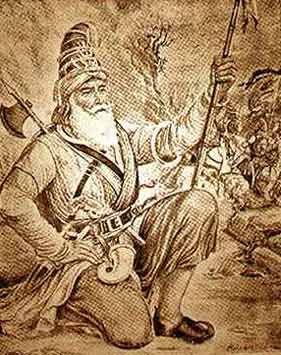
The career of Phula Singh illustrates both their defects and their qualities. This great Akali first came into notice as the leader of the attack on Metcalfe's escort at Amritsar in 1809. He was then employed by Ranjit Singh, who stood in considerable awe of him, as a leader in the Indus valley, where he was guilty of atrocious cruelty towards the Mohammedan population, and in Kashmir. Finally, Phula Singh and his Akalis contributed to, or rather virtually won for Ranjit Singh, the great Sikh victory over the Yusafzais at Teri in 1823. In this battle Phula Singh met with a heroic death, and his tomb at Naushehra is now an object of pilgrimage to Hindus and Mohammedans alike.
(see also Akali Phula Singh in 'Warriors' section)
Under Phula Singh's earlier leadership, and perhaps befor his rise, the Akalis had become a terror to friends and for alike, and the Sikh chiefs, from whom they often levied contribution, dreaded them by force. Ranjit Singh, after 1823, ddid much to reduce their power, and the order lost its importance.
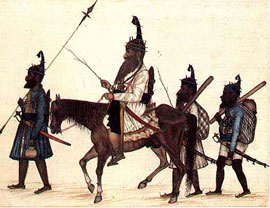
Akali Sikhs on the march
The Akali headquarters were the Akal Bunga at Amritsar, where they assumed the direction of religious ceremonies and the duty of convoking the 'Gurmatta'; indeed, they laid claim to exercise a general leadership of the Khalsa. Since Ranjit Singh's time Anandpur has been their real headquarters, but their influence has to a large extent passed away, and some of them have degenerated into mere buffoons.
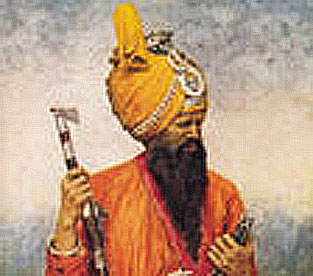
As an order the Akalsi are celibate. They have , says Trumpp, no regular chief or disciple, yet one hears of their Guru, whose leavings are eaten by their disciples (sewak or chela). They do not eat meat or drink spirits, as other Sikhs do, but consume inordinate quantities of bhang.
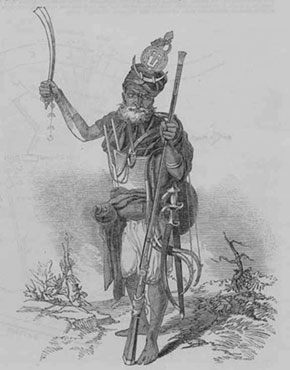
A painting done in 1846 of a Nihang Chieftain



